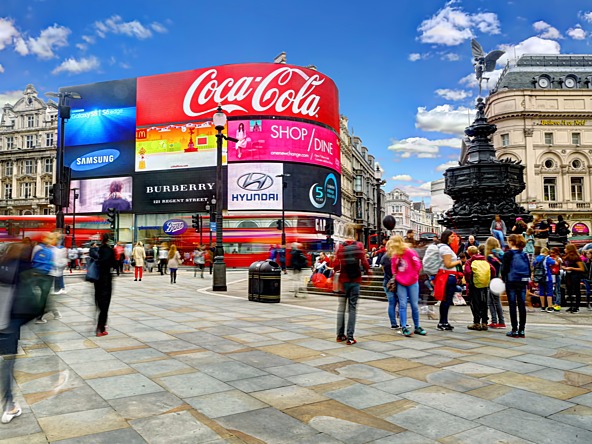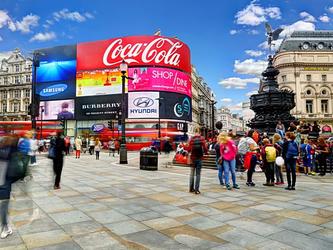Advertising spend rises a quarter despite inflation

The data for the first three months of the year showed a year-on-year rise of 28.3% in ad spend across all media, outperforming expectations by 7.7 percentage points.
As a result, the AA/Warc upgraded their outlook for the total UK advertising market by 0.2 percentage points to 10.9% growth.
The analysis found that online advertising was the biggest area for the advertising industry, accounting for 74.3% of all ad spend this year and rising from 73.5% in 2021.
The latest data suggests the UK advertising industry is on course to reach a total valuation of £37bn in 2023, a 4.4% increase on 2022.
However, despite the positive results, when inflation was taken into account UK advertising had real-terms growth of 1.8%.
The impact of inflation was also likely to translate into a real terms contraction of 1% in 2023.
The AA and Warc said that increased costs were also likely to erode margins and affect marketing budgets, with inflationary pressure likely to continue into 2023.
Stephen Woodford, chief executive at the AA, said: “It is encouraging to see growth in our industry over Q1, as the economy continues its recovery year-on-year following last year’s Covid-19 lockdown.
“However, the pressures of inflation on living standards and economic growth are at the top of everyone’s mind, and these rising costs may represent a real-term contraction of nearly 1% in 2023 for UK advertising investment.
“As the UK’s political leadership changes, it is important to recognise the value that advertising brings to the economy in supporting competition, innovation and growth at this critical time.”
James McDonald, director of data, intelligence and forecasting at Warc, said: “The latest survey data show that the UK’s ad market is currently experiencing a soft landing from the turmoil caused by the Covid-19 outbreak, with early budget commitments translating into a strong start to the year for the industry – all media recorded growth in the first quarter.
“As predicted, however, inflation is now starting to bite; its impact on the consumer is well documented, but the rising cost of servicing government debt leaves the incoming prime minister with less fiscal flex for stimulating flatlining economic activity.
“For advertisers, higher costs will carve into margins, and while a real term rise of 1.8% in ad investment is expected this year – compared to a pre-Covid-19 average of +2.6% – the market is now set to contract in 2023 after accounting for these ongoing inflationary pressures.”
Reaction
Allan Blair, head of strategy, VaynerMedia London
Despite the proclamations of many at the traditional end of the ad industry, we have been hurtling towards a digital-first world for years. Consumer behaviour during the pandemic only accelerated this. As the cost-of-living crisis continues to bite, we will undoubtedly see a decline in overall ad spend, but we expect to see digital hold strong, if not increase.
It’s not just the efficiency and accountability of media that attracts advertisers, it’s the sheer amount of attention it drives and relevance it offers to those wanting to strengthen their brand. As smartphones become an extension of our bodies, and social becomes our interface with the world, where else would brands turn to? Not just to drive frequency and reach but depth and engagement too.
It’s why, in addition to paid media, we are seeing brands increasingly invest in organic social. They recognise that, as the world gets tougher for real people, they need to work harder to grab them, be sympathetic to their needs and find authentic ways to play a role in their lives.
Justine O’Neill, senior director, Analytic Partners
It’s promising to see UK ad spend outperforming previous expectations with a year-on-year rise of 28.3%, particularly during a time with many external financial pressures – but the real term picture is less rosy once inflation is factored in. While many may be tempted to tighten their media budgets during hard times, our ROI Genome research shows that brands that held their nerve and invested in paid advertising during a recession saw a 17% rise in incremental sales.
Businesses must protect their marketing spend and recession-proof their strategies. A multi-channel approach is an effective way to mitigate the effects of the recession – using multiple marketing channels can increase advertising impact by 35%.
Ben Davis, analyst, Econsultancy
Q1 felt like the calm before the storm, with these strong ad spend growth figures, particularly in search, display and social, part of the ongoing rebound from the pandemic.
Advertisers will try to temper budget cuts over the rest of the year by being more efficient with their online media spend, something which arguably isn’t as easy in an increasingly (third-party) cookieless environment.
Retail will be a particularly interesting sector over the second half of 2022, with many retailers needing to sell excess stock online, and shoppers waiting for the best bargains or doing their holiday shopping early to take advantage of sales. These retail brands will have to be experts at multichannel marketing, integrating messaging, merchandising and customer relationship management with their paid media strategy if they are to maximize margin and reduce waste.
Nikki Cunningham, managing director, Curious London
It’s no surprise that online formats have seen the biggest growth this quarter. The pandemic, of course, significantly fuelled the growth of digital and from a design and branding perspective, we’re finding that all of our work includes some aspect of digital nowadays.
It’s also very promising to see UK ad spend as a whole continue to rise, and it’s a sign that the communications industry can not only bounce back after facing hardship, but will also exceed expectations. This will be key to keep in mind over the coming months, as with uncertainties such as the cost-of-living crisis looming, we will all be feeling the pressure of budget tightening.
As an industry, the last two years have helped us to understand how to navigate through turbulent times, and the next 12 months will be no different. However, we can enter this period with the optimism that the industry is resilient, and can withstand such uncertainty.

We hope you enjoyed this article.
Research Live is published by MRS.
The Market Research Society (MRS) exists to promote and protect the research sector, showcasing how research delivers impact for businesses and government.
Members of MRS enjoy many benefits including tailoured policy guidance, discounts on training and conferences, and access to member-only content.
For example, there's an archive of winning case studies from over a decade of MRS Awards.
Find out more about the benefits of joining MRS here.














0 Comments